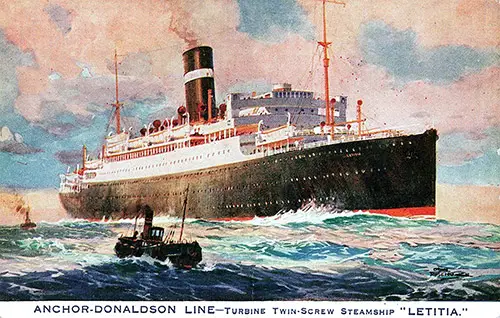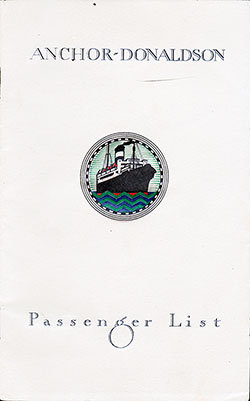SS Letitia Passenger Lists 1930

Anchor-Donaldson Line, Turbine Twin-Screw Steamship SS Letitia (1925). GGA Image ID # 1d214eddf2
Letitia (1925) Anchor-Donaldson Line.
Built by Fairfield Shipbuilding & Engineering Co., Glasgow, Scotland. Tonnage: 13,475. Dimensions: 525' x 66'. Twin-screw, 15 1/2 knots. Steam turbines. Two masts and one funnel. Maiden voyage: Glasgow-Quebec-Montreal, April 1925. Renamed: (a) Empire Brent (1946), (b) Captain Cook (1952). Served as emigrant ship to Australia and New Zealand. Sold to British shipbreakers. Sister ship: Athenia.
All Digitized Passenger Lists For the SS Letitia Available at the GG Archives. Listing Includes Date Voyage Began, Steamship Line, Vessel, Passenger Class and Route.

1930-08-22 SS Letitia Passenger List
- Steamship Line: Anchor-Donaldson Line
- Class of Passengers: Cabin
- Date of Departure: 22 August 1930
- Route: Glasgow to Québec and Montréal via Liverpool and Belfast
- Commander: Captain David Taylor
Passenger Lists contained in the GG Archives collection represent the souvenir list provided to the passengers of each cabin class (and other classes). Many of these souvenir passenger lists have disappeared over the years. Our collection contains a sampling of what was originally produced and printed by the steamship lines.
Launch of the New Liner Letitia
A cable from Glasgow to the Cunard Line announced the successful launching of the Anchor-Donaldson liner Letitia, Mrs. Charlea Donaldson, wife of the Chairman of the Company performing the christening ceremony. The Anchor- Donaldson Line operates between Canada, Ireland, and Scotland.
The new steamer is a sister ship of the Athenia, her predecessor by a year. Added to her many new features is a nursery in the third class, an innovation in this accommodation.
The Letitia will ply between St. Lawrence ports and the Clyde during the summer months, transferring to Portland, ME, for the winter months when the St. Lawrence is frozen over.
Brief History of the SS Letitia
The S.S. Letitia was a solid but unremarkable addition to the Anchor-Donaldson fleet. Registered 13,475 tons, she was 525 feet long with a 66ft beam with a service speed of 15 knots.
The Letitia was converted to serve as an armed merchant cruiser. The British Admiralty requisitioned the ship in the early days of WW2. It was rapidly made clear that large liners were unsuitable for such service.
She was withdrawn in 1941 to become a troopship. The Letitia was later used as a hospital ship in Canada for the duration of the war after being heavily damaged in 1943.
The Letitia returned to civilian service in 1946, purchased by the Ministry of Transport, who renamed her Empire Brent and assigned Donaldson Brothers & Black to manage her. The ship could be found carrying troops to the Far East and was used as an emigrant ship to Australia.
Briefly laid up in 1950, she was returned to service under charter to the Government of New Zealand as Captain Cook. She was finally withdrawn from service in 1960 and sold for scrap to Ward's of Hull.
⚠️ About Accuracy in Historical Records Research Tip
Context. The GG Archives presents passenger lists as faithfully as possible to the original documents. While OCR is generally accurate, portions of these collections—especially image captions and some transcriptions—are typed by hand and may include typographical or spelling variations. The original manifests themselves also contained clerical inconsistencies (names recorded phonetically, mid-voyage corrections, etc.).
What this means for your research:
- Search variant spellings of names (e.g., “Schmidt/Schmitt/Smith,” “Giuseppe/Joseph”).
- Cross-reference with immigration cards, passport applications, naturalization files, city directories, and newspapers.
- Treat manifests as primary sources with historical quirks—use them alongside corroborating records.
- For place names, consider historical borders and language variants (e.g., Danzig/Gdańsk, Trieste/Trst).
How to cite. When quoting a name from a manifest, consider adding [sic] for obvious misspellings and include a note such as “spelling as printed in original passenger list.”
Need help? If you spot a likely transcription error in captions, feel free to contact us with the page URL and a brief note—we love community input. 🙏
Curator’s Note
For over 25 years, I've been dedicated to a unique mission: tracking down, curating, preserving, scanning, and transcribing historical materials. These materials, carefully researched, organized, and enriched with context, live on here at the GG Archives. Each passenger list isn't just posted — it's a testament to our commitment to helping you see the people and stories behind the names.
It hasn't always been easy. In the early years, I wasn't sure the site would survive, and I often paid the hosting bills out of my own pocket. But I never built this site for the money — I built it because I love history and believe it's worth preserving. It's a labor of love that I've dedicated myself to, and I'm committed to keeping it going.
If you've found something here that helped your research, sparked a family story, or just made you smile, I'd love to hear about it. Your experiences and stories are the real reward for me. And if you'd like to help keep this labor of love going, there's a "Contribute to the Website" link tucked away on our About page.
📜 History is worth keeping. Thanks for visiting and keeping it alive with me.
